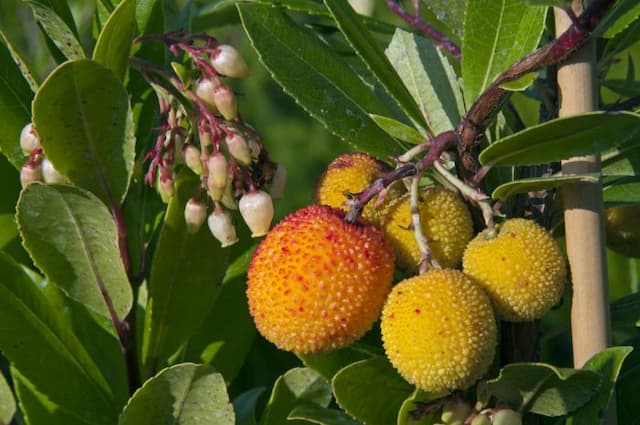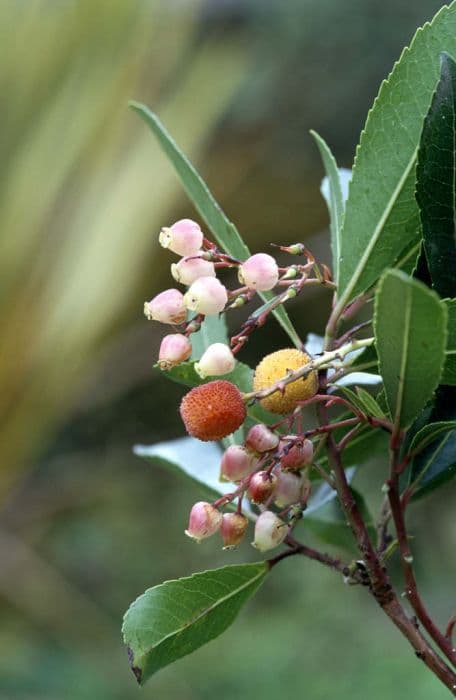Cornish Heath Erica vagans f. aureifolia 'Valerie Proudley'











ABOUT
The Erica vagans f. aureifolia 'Valerie Proudley', commonly known as Cornish heath, boasts a striking appearance with vibrant colors that stand out in any garden. This lovely evergreen shrub has needle-like foliage that features a golden-yellow hue, creating a bright and eye-catching backdrop throughout the year. The golden leaves bring a warm contrast to the plant's delicate flowers. During its blooming season, the Cornish heath is adorned with masses of bell-shaped flowers that exhibit a rich pink color. These blossoms are tightly clustered at the tips of the branches, adding a soft yet vibrant texture to the plant's overall look. The vivid pink flowers against the golden foliage make for a stunning display that can attract various pollinators, adding to its ornamental appeal. The branching structure of the Cornish heath is relatively dense, giving the shrub a full and lush appearance. The branches sprawl outward, creating a slightly mounded form that can complement other plants in a mixed border or stand on its own as an eye-catching specimen. This cultivar's combination of striking foliage and vibrant flowers makes it a popular choice for gardeners looking to add long-lasting color to their landscapes.
About this plant
 Names
NamesFamily
Ericaceae.
Synonyms
Cornish Heath, Golden Cornish Heath.
Common names
Erica vagans f. aureifolia 'Valerie Proudley'.
 Toxicity
ToxicityTo humans
The common name for Erica vagans f. aureifolia 'Valerie Proudley' is Cornish heath. Generally, Cornish heath is not known to be toxic to humans. However, it is advisable to keep in mind that individual sensitivity to plants can vary, so it is always best to avoid ingesting any part of ornamental plants as a precaution. If an individual were to have an atypical reaction after ingesting parts of the plant, they could potentially experience gastrointestinal discomfort or an allergic reaction. If you suspect poisoning, you should contact a medical professional or poison control center immediately.
To pets
The common name for Erica vagans f. aureifolia 'Valerie Proudley' is Cornish heath. Cornish heath is not typically recognized as a toxic plant to pets. Cats and dogs can often come into contact with various garden plants without incident; nevertheless, pets, like humans, may have sensitivities or allergies that are specific to them. While there is no specific toxicity associated with Cornish heath, it is always best to prevent your pets from chewing on or ingesting any non-food plants. Ingestion could potentially lead to mild gastrointestinal upset due to irritation from the plant material. If you notice any unusual signs or symptoms in your pet after ingestion, such as vomiting, diarrhea, or signs of distress, contact your veterinarian for guidance.
 Characteristics
CharacteristicsLife cycle
Perennials
Foliage type
Evergreen
Color of leaves
Green
Flower color
Pink
Height
1-2 feet (30-60 cm)
Spread
1-2 feet (30-60 cm)
Plant type
Shrub
Hardiness zones
7
Native area
Europe
Benefits
 General Benefits
General Benefits- Attracts Pollinators: The flowers of the Cornish heath are known to attract bees and butterflies, which play an essential role in pollination.
- Landscape Beautification: With its vibrant foliage and flowers, the Cornish heath adds color and aesthetic appeal to gardens and landscapes.
- Drought Tolerance: Once established, the plant has a degree of drought tolerance, making it suitable for gardens with low water availability.
- Low Maintenance: The Cornish heath generally requires minimal care once it has taken root, making it a convenient choice for gardeners.
- Seasonal Interest: The plant has a long flowering period, providing visual interest from midsummer to fall and sometimes through mild winters.
- Wildlife Habitat: This plant can offer shelter and nourishment to various small wildlife species in its native and adapted environments.
- Soil Erosion Control: The Cornish heath, with its dense growth habit, can help stabilize soil and prevent erosion on slopes or in problematic areas.
- Adaptability: It can adapt to a range of soil types, although it prefers acidic conditions, providing flexibility in garden design.
- Compact Growth: The plant's compact and neat growth habit makes it suitable for borders, rock gardens, and areas with space constraints.
 Medical Properties
Medical PropertiesThis plant is not used for medical purposes.
 Air-purifying Qualities
Air-purifying QualitiesThis plant is not specifically known for air purifying qualities.
 Other Uses
Other Uses- Crafting Dried Flower Arrangements: The Erica vagans can be used to create beautiful dried flower displays as its small flowers maintain their shape and color when dried.
- Natural Dyes: The foliage and flowers can be boiled to produce natural dyes for fabrics or art projects.
- Eco-friendly Confetti: Dried petals from the Cornish heath can be used as biodegradable confetti for weddings or celebrations.
- Garden Borders: Cornish heath can be planted to form attractive, low borders in gardens, separating different areas with its dense foliage.
- Miniature Bonsai: With careful pruning, the Cornish heath can be cultivated as a miniature bonsai, making an interesting hobby plant.
- Photography Prop: Its picturesque blossoms provide a beautiful backdrop or subject for photography enthusiasts, especially macro photography.
- Floral Perfume Essence: The subtle fragrance of the flowers can be captured and used in homemade floral perfumes or potpourri.
- Insect Habitat: Planting Erica vagans can help attract and provide a habitat for beneficial garden insects like bees and butterflies.
- Educational Tool: Schools and educational programs can use the plant to teach students about plant life cycles and pollination.
- Frost Protection: Using the plant in a garden can provide ground cover that can help protect the soil and other plants from frost damage due to its dense foliage.
Interesting Facts
 Feng Shui
Feng ShuiCornish Heath is not used in Feng Shui practice.
 Zodiac Sign Compitability
Zodiac Sign CompitabilityCornish Heath is not used in astrology practice.
 Plant Symbolism
Plant Symbolism- Endurance: The heath plant, to which Erica vagans belongs, is known for its resilience and ability to thrive on rugged, barren terrains, symbolizing one's ability to endure challenging conditions and remain strong.
- Protection: Heath has been traditionally used for protection due to its dense growth, which provides shelter and safety for various forms of wildlife, representing the concept of providing a safe haven or sanctuary.
- Solitude: As a plant that grows in open heathlands, often isolated from other flora, it can be seen as a symbol of solitude and contemplation, encouraging moments of self-reflection and inner peace.
- Beauty: The 'Valerie Proudley' variety, with its striking foliage and flowers, represents an appreciation for natural beauty and the joy it can bring into one's life.
- Good luck: In some cultures, giving someone heath is considered a gesture of good luck, making it an emblem of hope and positive future prospects.
- Adaptability: This cultivar, like other members of the Erica genus, shows versatility in its ability to adapt to various soil types and climates, symbolizing flexibility and the ability to thrive in different conditions.
 Water
WaterThe Cornish Heath should be watered thoroughly, allowing the soil to become moderately dry between waterings. During active growth in spring and summer, you may need to water as often as every week. Use approximately one gallon of water per plant for each watering session, ensuring even distribution around the base. Reduce frequency in the fall and winter when the plant is not actively growing, to about once every two to three weeks. Always check the top few inches of soil for moisture before watering to avoid overwatering.
 Light
LightCornish Heath thrives in full sun to partial shade. The ideal spot for this plant is an area where it can receive at least six hours of sunlight daily, but it can also do well with light afternoon shade. Avoid deep shade locations, as insufficient light can lead to poor flowering and growth.
 Temperature
TemperatureCornish Heath prefers a cool to moderate climate and can survive in temperatures ranging from about 20°F to 70°F. The ideal temperature for this plant would be between 50°F and 65°F. Protect the plant from extreme heat and cold to prevent damage to the foliage and roots.
 Pruning
PruningPrune Cornish Heath to maintain its shape and promote bushier growth, preferably in late winter or early spring before new growth starts. It's also essential to remove dead or damaged stems to encourage healthy new growth. Pruning can be done annually, shaping the plant according to your desired size and form.
 Cleaning
CleaningAs needed
 Soil
SoilCornish Heath 'Valerie Proudley' requires a soil mix that is well-draining, rich in organic matter, and slightly acidic. The ideal soil pH for this plant should be between 4.5 and 5.5. A mix of peat or ericaceous compost with perlite or sand to aid drainage would be suitable.
 Repotting
RepottingCornish Heath 'Valerie Proudley' should be repotted every 2 to 3 years or when it outgrows its current pot. Use ericaceous compost when repotting to maintain the acidic soil conditions it thrives in.
 Humidity & Misting
Humidity & MistingCornish Heath 'Valerie Proudley' prefers moderate humidity levels but is quite adaptable. The plant does well in the typical humidity found in most home environments.
 Suitable locations
Suitable locationsIndoor
Place Cornish Heath 'Valerie Proudley' in bright, indirect light indoors.
Outdoor
Grow Cornish Heath 'Valerie Proudley' in acidic soil with partial shade.
Hardiness zone
7-9 USDA
 Life cycle
Life cycleErica vagans f. aureifolia 'Valerie Proudley', commonly known as Cornish Heath or Mrs. D.F. Maxwell, begins with seed germination, which typically occurs in a stratified, cool, and moist environment. Seedlings develop a root system and foliage, adapting to their surroundings during the growth stage. As they mature, they enter a vegetative state, establishing an evergreen shrub structure and foliage that is green with golden tips. Once the plant reaches maturity, usually after a few years, it blooms in late summer to autumn, displaying a profusion of small, bell-shaped, pink flowers. After pollination, typically by bees or other insects, seeds develop within the fruits and are eventually dispersed by wind or wildlife to begin a new lifecycle. During winter, Cornish Heath may enter a period of dormancy, with reduced growth activity, until the warmth of spring initiates a new cycle of growth and flowering.
 Propogation
PropogationPropogation time
Spring-Early Summer
The most popular method of propagation for the Cornish Heath, specifically the variety Erica vagans f. aureifolia 'Valerie Proudley', is through semi-ripe cuttings. This technique is typically performed in late summer. To do this, one would select healthy, non-flowering shoots that have partially matured. The chosen shoots are then cut into lengths of about 2-4 inches (5-10 centimeters), with the lower leaves removed to expose the stem. Dipping the cut end into rooting hormone can enhance the chances of successful root development. The prepared cuttings are inserted into a mix of peat and perlite or other well-draining propagation medium and kept under conditions of high humidity and indirect light until they root, which usually occurs in several weeks to a few months.









